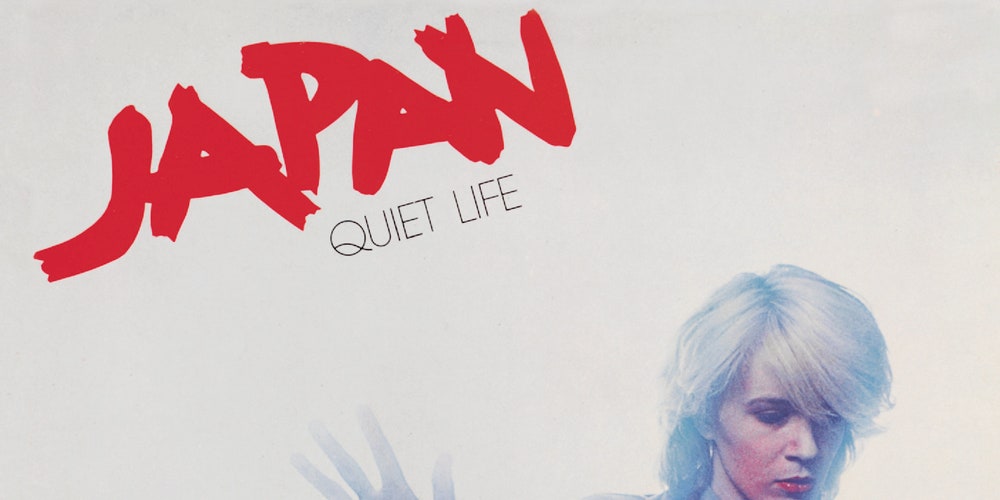Before they became synonymous with heady, ethereal synth pop, Japan started out under the sway of Bowie and Bolan. On their first two albums, Adolescent Sex and Obscure Alternatives, both released in 1978, singer/guitarist David Sylvian affected a nasal sneer while the rest of the band (drummer Steve Jansen, bassist Mick Karn, keyboardist Richard Barbieri, and guitarist Rob Dean) backed him with icy, funk- and glam-infused rock. They even had the cheek to cover the decidedly unhip “Don’t Rain on My Parade,” a song from the 1964 Broadway musical Funny Girl. But as the chemistry within the band tightened and their interests expanded to include Kraftwerk, Roxy Music, and Brian Eno, they were eager to grow. “We got the first album completely wrong, so we did another and that was wrong as well,” Sylvian recalled in a 1986 interview. He felt so strongly about this that he regarded Japan’s third LP, 1979’s Quiet Life, as the band’s proper debut.
There’s a measure of truth to Sylvian’s ahistorical take on Japan’s discography. As heard on a new deluxe reissue, Quiet Life presaged the mature beauty of the band’s final albums and Sylvian’s eventual solo career. The barbed agitation of Japan’s early work gave way to a controlled, sensual sound built from droning synths, bleating saxophone, and complex, jazzy rhythms, with Sylvian floating above it all like the omniscient narrator of a sci-fi noir film. Alongside other albums of the era like Siouxsie and the Banshees’ Kaleidoscope and PiL’s Metal Box, Quiet Life served as a bridge between post-punk and the burgeoning new-wave scene.
Japan’s first step away from those so-called mistakes was a blatantly commercial one. In hope of capitalizing on the success of Obscure Alternatives’ overseas success, their label, Hansa, put the group in an L.A. studio with Giorgio Moroder. The band had already written “European Son” as an homage to the Italian producer’s sequencer throb; rather than produce a version of that song, Moroder insisted they collaborate on something new. The track that came out of that session, “Life in Tokyo,” melds two distinct artistic approaches: Karn’s sliding fretless bass figure and Sylvian’s lyrics of urban disaffection fit perfectly with Moroder’s signature synth pulses and disco diva backing vocals.
While the single failed to chart, the session with Moroder bolstered Japan’s confidence as they continued woodshedding new material for their third album. What came out of the rehearsals were dynamic changes in their sound, placing new emphasis on the interplay between Karn’s rubbery bass playing and Jansen’s oblique rhythms, with Barbieri and Dean coloring in the edges with textural chords and quick melodic hits.
The biggest shift came as Sylvian began to adopt a restrained croon inspired by Roxy Music’s Bryan Ferry. This new timbre allowed him to vary the emotional temperature of Quiet Life’s material. Some of the snarl of the early albums remains on “Fall in Love With Me” and the ragged “Halloween,” but other tones were creeping in. On the Moroder-inspired title track, his voice evokes the exhaustion and tension inherent in his lyrics, which speak to the strange tug-of-war between the desires for pop success and anonymity. And on the somber album closer “The Other Side of Life,” Sylvian is overcome with wistful yearning, as if already nostalgic for his time in the group, which would disband within three years.
Some of the band’s changes of that period manifest as growing pains on Quiet Life. The plodding cadence and honking sax lines of “Fall in Love With Me” sit uncomfortably between the disco-pop shimmy of the title track and the hissing drum machine and chilly atmosphere of “Despair.” The LP’s second side is even more oddly paced. The faltering beat and glam guitars of “Halloween” do a poor job preparing listeners for a skewed cover of the Velvet Underground’s “All Tomorrow’s Parties,” which sets a Fripp-like guitar whine against a Motown backbeat, followed by the stiffly funky prog-pop of “Alien.”
Japan’s label didn’t seem to know what to do with Quiet Life. Outside the UK, Hansa pushed the title track as a single, but on their home turf it was relegated to the B-side of the band’s ill-fitting cover of Smokey Robinson’s “I Second That Emotion,” included here in both its 7" and 12" versions. They also issued a live EP that featured only one song from the freshly released album. (That EP and a variety of mixes of the singles from this era make up the second disc of this set.)
The album and its accompanying singles failed to make a commercial dent in the UK, but the band was still a sizable draw in Japan’s namesake country. On the tour for Quiet Life, Karn recalled in his memoir Japan & Self Existence, fans chased down their taxis and stuffed their phone numbers into the men’s pockets. The screaming during the band’s concert at Tokyo’s Budokan indoor arena in 1980 bears out their popularity there. Unfortunately, that live document, which comprises the third disc in the set, sounds like it was sourced from an audience recording, and the music is muffled and ugly to listen to.
Everything would eventually fall into place for Japan, albeit briefly. After breaking ties with Hansa, they would sign with Virgin Records and produce two confident and stunning albums, 1980’s Gentlemen Take Polaroids and 1981’s Tin Drum, scoring an unlikely No. 5 hit in the UK with the poignant single “Ghosts.” But to get to that point, Japan had to go through the period of growth that resulted in Quiet Life, straining against the limits of their abilities as songwriters and musicians in order to move beyond them. As heard in the context of the group’s history, this album, however imperfect, feels rich with possibility and promise.
Buy: Rough Trade
(popitrecords.com.)
Catch up every Saturday with 10 of our best-reviewed albums of the week. Sign up for the 10 to Hear newsletter here.
